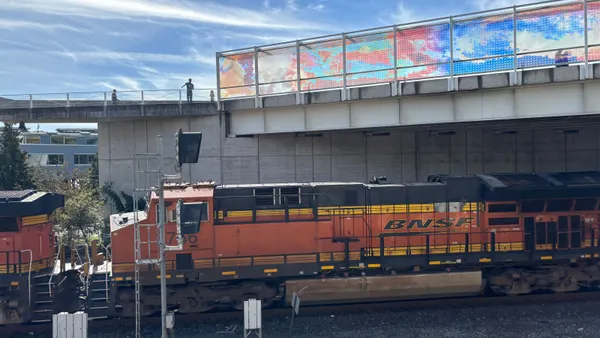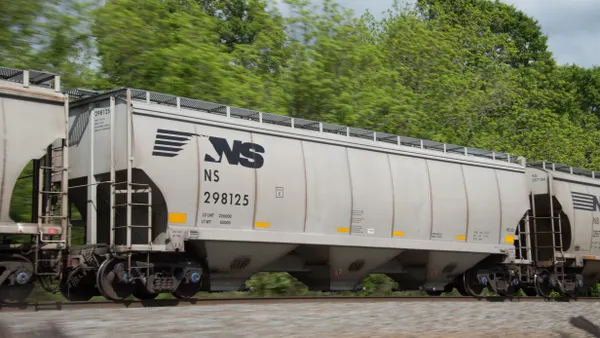Dive Brief:
- Even as overall freight volumes continue to disappoint railroads, Union Pacific announced solid progress on the efficiency KPIs it adopted along with the principles of precision-scheduled railroading (PSR), executives said on a third-quarter earnings call Thursday.
- Revenue in the third quarter was down 7% year-over-year — a more dramatic drop then the 2% year-over-year decrease the railroad saw in the second quarter. Volume in the third quarter was down 8%, double the 4% decrease in the previous quarter. "If we can get a little cooperation from the economy, that would be very helpful," said CEO Lance Fritz.
- In addition to a depressed industrial economy and an uncertain consumer economy, executives said converting more traffic from trucks to rail — an expressed aim of PSR and goal for all Class I's — is going to take some time. "Trucks are pretty darn loose right now, which means the capacity is readily available and widely reported that truck pricing has been dropping. So we are looking forward to seeing a bottom of that and then an upturn," Fritz said.
Dive Insight:
Service has improved, said Jim Vena, the railroad's COO and PSR czar, but it will take time for customers to realize it. Just as weather issues resolved for the railroad, the spot market for trucks dropped, leaving railroads with tough decisions in terms of pricing, said Vena.
"We have always said that we would like to be ... 10% to 15% lower than the contracted rates and so we will continue to see what happens in the marketplace going forward," Vena said. Intermodal volume for the railroad was down 12% in the third quarter.
Most Class I railroads (excluding BNSF) have been under pressure to balance the restructuring work PSR often begets, with declining volumes for at least two quarters. Vena described this as "rightsizing our cost structure in the face of declining volumes while driving significant productivity."
He gave the example of crew starts versus carloads. In the third quarter, crew starts were down 15% from the previous one, but carloads were only down 8% — meaning the railroad is decreasing labor costs more significantly than volume is shrinking and the cuts are not all due to the volume dip.
With volumes down and no sure rebound in sight, despite some expectation of a normal seasonal bump in the fourth quarter, analysts and investors are even more focused on efficiency since Union Pacific's work implementing the principles of PSR has so far softened the blow of low volume on the railroad's revenue and profitability.
On that front, the railroad touted its longer train lengths, 20% year-over-year reduction in terminal dwell and 10% improvement in freight car velocity. Additionally, Union Pacific's operating ration in the third quarter was 59.5% — lower than its full-year goal of below 61%. Even with these gains, Vena explained there is room for further improvement.
After three quarters of consistent efficiency gains, even in the face of depressed volumes, questions from analysts often focus on how much more fat railroads can trim.
Lower volumes can help lean out Union Pacific even more, since lower volume will likely lead to more headcount reduction than the 6% the railroad expects in 2020. But Vena said he'd still be able to make more progress with volume, then without.
"Volume helps us in that we are able to really run the place more efficiently and more — as cars come on on the same trains that we are operating on. So I see volume as a helper. It helps us both topline and bottom line," said Vena.













